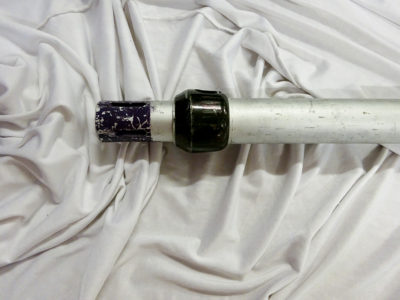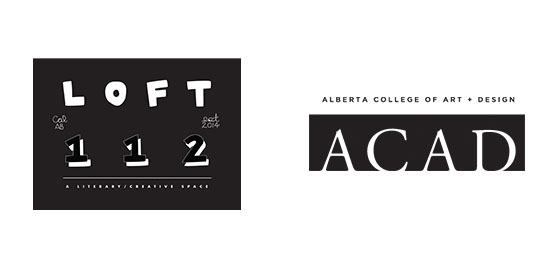
Correctional Service Canada Accommodation Guidelines: Mental Healthcare Facility 10m2 x 2
Sheena Hoszko
January 13 – February 18, 2017
Hoszko’s show will be accompanied by a two-week residency in partnership with Loft 112. During this time, she will be presenting her lecture, “Outsiders: The Limits of Representation of Carceral Spaces” at the Alberta College of Art and Design on January 17 at 2PM in Gallery 2 of the Illingworth Kerr Gallery, as well as her workshop, “Prison, Maps, & Health: Keisha Williams interviewed by Sheena Hoszko” on January 21, 2:30-4:30 at Loft 112. These events are free admission and all are welcome.
Exhibition Description
Correctional Service Canada Accommodation Guidelines: Mental Healthcare Facility 10m2 x 2 is a sculptural artwork based on the Correctional Service Canada’s (CSC) “Federal Correctional Facilities Accommodation Guidelines.” Obtained in 2015 via an access-to-information request, this 700-page document is used by CSC for the building, maintenance, and everyday operations of prisons. In a section named “Mental Healthcare Facility,” CSC outlines the locations and spatial dimensions required for waiting rooms, bathrooms, and staff offices for the mental health wing in a prison. People with severe trauma and/or mental illnesses, due to a lack of resources for their care on the outside, are disproportionately imprisoned by CSC.[1] Parallel to this, symptoms of mental illness increase when people are incarcerated; the notion of “care” in a carceral context is thus an oxymoron, as the conditions of imprisonment are incongruent with treatment or rehabilitation. [2]
Correctional Service Canada Accommodation Guidelines: Mental Healthcare Facility 10m2 x 2 consists of two closed structures that fill The New Gallery space, referring specifically to the 10m2 minimum spatial requirements for mental heathcare waiting rooms and treatment rooms. Within the gallery these spaces are constructed out of rented “pipe and drape,” a type of temporary architecture often used for dividing spaces within warehouses, stadiums, office buildings, and other open environments. “Walls” of pipe and drape hang from ceiling to floor, recalling dividers from ambiguous institutional spaces, like hospital curtains or cubicle separators—a provisional architecture that both reveals and hides. Once the exhibition period is over, the materials are returned to the rental company to be used again, suggesting that structures of incarceration circulate widely throughout society. The rooms take up most of the exhibition space; unable to enter the structures, viewers are thus constrained to the rest of the gallery with limited room to move.
[1] Fiona G. Kouyoumdjian, Andrée Schuler, Stephen W. Hwang and Flora I. Matheson, “Research on the Health of People Who Experience Detention or Incarceration in Canada: A Scoping Review,” BMC Public Health 15, no. 419 (April 25, 2015), accessed August 12, 2016, doi:10.1186/s12889-015-1758-6.
[2] Peter Collins, “The Pathology of Rehabilitation,” Scapegoat 7 (Fall/Winter 2014): 217–32, accessed January 12, 2015, http://www.scapegoatjournal.org.
Dear Sheena,
So hard to write now, to keep writing, to think while we all grieve. What exactly are we grieving now? And how is it that even though we know not much has changed, we also know that so much has and so much will? I don’t even want to write the name. I don’t even want to name what embodies all that horror. How do we name, give a name, to the violence that is to come, even as it is already here? But things will change for the worse, no matter what—that is certain. I am flooded with the feeling that overtook my body after 9/11. Maybe we can call it fear for now. But it was more than that. My first thought: so many more people of colour are going to end up in prison. And surely, by now you’ve heard that on November 9, 2016, there was a 43.13% hike in stocks for the Corrections Corporation of America.
You asked me to write something for your show, for what you made that will be presented in a gallery space, and I thought deeply about how a written piece would matter in such a context, how it would stand alongside the work, presented in the space. As a writer, I am honoured that you asked me to participate. I assume you also asked me because I know some things about carceral spaces, and because you have heard me call myself a prison abolitionist.
But I want to stop claiming that as an identity. Nothing is done in pronouncing who I am, a mere representation of a self. My initial intention in writing so, saying so, and proclaiming so held me responsible to a politic I did not yet understand. Doing so held me accountable; I would have to take action that was louder than my word.
I came to prison abolition through intuition, trying to sustain emotional distance from my research work on Palestine. I took a detour into architecture, to think materially about how spaces of violence are constructed, which gave me the space to think less emotionally about their effects and how they were hurting my body. This started with understanding occupation and colonization as design projects. Not much can be done without the spaces that are built to do them in, to have those systems condition what is to be done. Focusing on the materiality of space gave me a more concrete view of the ideologies at play. It’s by drawing that line on the map, the one that makes a space appear, that relations are conditioned on the ground—whether what is being built is a settlement or a prison. The landscape shifts, and bodies are affected; lives are at stake. Colonization and occupation have led to mechanisms of incarceration that expand beyond the prison itself. I know you know this. Your work shows this, and tries to let us in on the effects. “Us,” meaning people on the outside, “us” who just don’t know.
It is very difficult to access information on prisons in Canada. Corrections Services Canada (CSC) does a good job of hiding what happens inside, keeping this secret from the public. Your work is so important because it offers a way in for people who are not privy to the information that the design manual provides. Those on the outside who have never been inside a Canadian prison, who have never been incarcerated, don’t know what that space looks like, how it functions, what it does, and how it conditions and perpetuates violence. By providing a glimpse into the design elements of CSC you allow us to think further about the accountability of practitioners, such as architects and designers, and how the building of prisons extends beyond a national issue, as a capitalist, global project.
Prisons function as the implementation of new borders, and people are fundamentally separated from each other based on this fact. The inside and outside become a specific boundary. Creating the infrastructure creates a border, and people are separated from the population, the public realm. Carceral spaces are based on separation and isolation. I feel, Sheena, that your work challenges this violent manoeuvre. To have us walk around a gallery, reconstituted as a carceral space, is to let us wonder about the effects of inside/outside. By having our bodies move, you allow us to think about the space differently, to experience the effects of enclosed space, perhaps affectively. That is because your sculptural work specifically considers the repressive elements of space in scale, precise measurement, and in construction. The design process is as important as the concept, and you remind us of this relationship between making, ethical positioning, and power. Most importantly, you are able to contextualize the effects of this relationship from within your own artistic sensibility.
I am a person who thinks and works through intuition, and rhythm. Often, I feel they determine how a piece functions; they condition the process, and therefore the outcome. In this way, my work is process-based, of the body. Intuition leads me to new inquiries, new stages; my body and how it’s feeling enables the next step. As my dear friends, Eunsong Kim and Gelare Khoshgozaran, put more eloquently, conceptualization is embodied.[1] It is in this embodiment that I see open possibilities in art’s potential as a platform for engagement, to communicate the urgencies and concerns of present-day struggle. Specifically, art can have an immediate effect on how we feel the struggle on our bodies. I think your sculptural work, and in particular its spatiality, demands that we pay attention to how our bodies are moving, looking, thinking—and most importantly, feeling.
This is when I think about intention, and how in intention we position ourselves as practitioners. How to extend beyond the materiality of the work, the outcome. Often it’s the process, the relationships, the events around making and doing that spark the initial idea. In this way, I also think often about form, what it enables. Form conditions content. I think your sculptural work conditions a spatial experience that lets us think and feel through the border of separation and isolation. In the end, we’re reminded that there is still an outside and an inside, as this piece is taking place inside a gallery, a space inaccessible to people inside prison.
When I think of the relation between intention, process and form, I think of what M. NourbeSe Philip says of language: “The struggle is to reduce the gap between the experience and the expression of that experience.”[2] I also think of Denise Ferreira da Silva, and her concept of Poethics, which suggests that ethics reside in how intention is constituted, that the significance of art is connected to an ethos and the relationships we create on the ground. In an interview I did with her, I asked her to elaborate on this term, and she said, beautifully, “The intention is in itself ethical. Poiesis—the ability to make the world and to make the world anew, to create— is guided by the ethical intention… [It] is to obliterate anything and everything that is deployed to justify (to render both morally acceptable and legal) colonial/racial violence.”[3]
-Nasrin Himada
[1] See Eunsong Kim and Gelare Khoshgozaran, ”Editorial Note to Feature #1,” contemptorary 1 (April 17, 2016), http://contemptorary.org/editorial-note-to-feature-1.
[2] M. NourbeSe Philip, “Interview with an Empire,” in Assembling Alternatives: Reading Postmodern Poetries Transnationally, ed. Romana Huk (Midtown, Connecticut: Wesleyan University Press, 2003), 195–206.
[3] Nasrin Himada, “Interview with Denise Ferreira da Silva,” Counter Signals 1 (Fall 2016).
Lecture
Outsiders: The Limits of Representation of Carceral Spaces
Tuesday, January 17, 2017, 2PM
Alberta College of Art and Design, Gallery 2 of the Illingworth Kerr Gallery (1407 14 Ave NW, Calgary, AB T2N 4R3)
Workshop
Prison, Maps, & Health: Keisha Williams interviewed by Sheena Hoszko
Saturday, January 21, 1-4PM
Loft 112 (112, 535 8 Ave SE, Calgary, AB T2G 5S9)
For this event, Toronto-based health organizer and artist Keisha Williams will be interviewed by Sheena Hoszko regarding her artist practice, health promotion, and anti-prison work. After the talk participants will be invited to use paper and other materials to map architectural spaces, from both memory and provided floor plans. The loft is wheelchair-accessible through the front lobby. Bathrooms are gender-neutral.
Biographies
Keisha Williams is a health promoter and artist working to support the health of all people, with a focus on health equity within Black/queer/trans/youth/racialized/criminalized/HIV+ communities. Currently working at PASAN, an HIV/AIDS service organization serving prisoners and ex-prisoners, she supports criminalized women and trans people. As a filmmaker and actor, she attempts to accurately portray the lives of those in communities she belongs to/works with. She fuses her experience as a health promoter with her work as a filmmaker, attempting to create socially relevant content that discusses health and social justice, while also promoting healthy sexuality. She was awarded an Access, Equity and Human Rights award in 2014 and is a recent award-winning graduate of the Masters of Public Health Program at the University of Toronto.
Nasrin Himada is a writer, editor, and curator residing in Toronto. Her interdisciplinary research focuses on experimental cinema, the relationship between art and poetry, and the militarization of urban space through prison infrastructure and police surveillance. She has lectured extensively on these topics, including presentations at the California Institute of the Arts, Georgetown University, and INCA Seattle. Her curatorial work has been exhibited at DHC/ART: Foundation for Contemporary Art, Echo Park Film Center, 16 Beaver, and Image + Nation. From 2011 to 2016, Nasrin co-edited the journal Scapegoat: Architecture/Landscape/Political Economy. She is the co-editor of the inaugural issue of MICE Magazine on the theme of invisible labour, and is presently the curator at Art Metropole.
Sheena Hoszko examines sculptural materiality as it relates to institutional power dynamics by mapping geographic and architectural sites on a 1:1 scale. She obtains these measurements by walking the perimeter and measuring her steps, transcribing oral histories, and via access to information requests. Her projects translate prison measurements, churches, and corporate/private building plans. She studied at the Emily Carr University of Art + Design and obtained an MFA from Concordia University, where she received a SSHRC grant for her research into feminism and post-minimalism. Selected solo exhibitions include Centre Clark and La Centrale (Montreal), A Space (Toronto), and Artspace (Peterborough), with an upcoming project at the Forest City Gallery (London). Hoszko lives and works in Montreal.
The artist would like to thank Ellen Gedopt, Pascale Busseau, Sadie at PRD, Keisha Williams, Mark Clintberg, Giselle Dias, Eveline Lupien at House9, the Canada Council for the Arts, and The New Gallery board and staff.
The New Gallery would like to extend a special thank you to Loft 112 and the Alberta College of Art + Design for their support of this project.


